#solar energy
Text
Japan is on track to beam solar power from space to Earth next year, two years after a similar feat was achieved by U.S. engineers. The development marks an important step toward a possible space-based solar power station that could help wean the world off fossil fuels amid the intensifying battle against climate change.
Speaking at the International Conference on Energy from Space, held here this week, Koichi Ijichi, an adviser at the Japanese research institute Japan Space Systems, outlined Japan's road map toward an orbital demonstration of a miniature space-based solar power plant that will wirelessly transmit energy from low Earth orbit to Earth.
Continue Reading.
103 notes
·
View notes
Text

Solar energy has so many benefits. Raising salaries for teachers is such a needed narrative.
36K notes
·
View notes
Text
"Cody Two Bears, a member of the Sioux tribe in North Dakota, founded Indigenized Energy, a native-led energy company with a unique mission — installing solar farms for tribal nations in the United States.
This initiative arises from the historical reliance of Native Americans on the U.S. government for power, a paradigm that is gradually shifting.
The spark for Two Bears' vision ignited during the Standing Rock protests in 2016, where he witnessed the arrest of a fellow protester during efforts to prevent the construction of the Dakota Access Pipeline on sacred tribal land.
Disturbed by the status quo, Two Bears decided to channel his activism into action and create tangible change.
His company, Indigenized Energy, addresses a critical issue faced by many reservations: poverty and lack of access to basic power.
Reservations are among the poorest communities in the country, and in some, like the Navajo Nation, many homes lack electricity.
Even in regions where the land has been exploited for coal and uranium, residents face obstacles to accessing power.
Renewable energy, specifically solar power, is a beacon of hope for tribes seeking to overcome these challenges.
Not only does it present an environmentally sustainable option, but it has become the most cost-effective form of energy globally, thanks in part to incentives like the Inflation Reduction Act of 2022.
Tribal nations can receive tax subsidies of up to 30% for solar and wind farms, along with grants for electrification, climate resiliency, and energy generation.
And Indigenized Energy is not focused solely on installing solar farms — it also emphasizes community empowerment through education and skill development.
In collaboration with organizations like Red Cloud Renewable, efforts are underway to train Indigenous tribal members for jobs in the renewable energy sector.
The program provides free training to individuals, with a focus on solar installation skills.
Graduates, ranging from late teens to late 50s, receive pre-apprenticeship certification, and the organization is planning to launch additional programs to support graduates with career services such as resume building and interview coaching...
The adoption of solar power by Native communities signifies progress toward sustainable development, cultural preservation, and economic self-determination, contributing to a more equitable and environmentally conscious future.
These initiatives are part of a broader movement toward "energy sovereignty," wherein tribes strive to have control over their own power sources.
This movement represents not only an economic opportunity and a source of jobs for these communities but also a means of reclaiming control over their land and resources, signifying a departure from historical exploitation and an embrace of sustainable practices deeply rooted in Indigenous cultures."
-via Good Good Good, December 10, 2023
#indigenous#native americans#first nations#indigenous rights#tribal sovereignty#solar energy#solar power#solar panels#renewable energy#green energy#sioux#sioux nation#sustainability#climate hope#electrification#united states#hope#good news
2K notes
·
View notes
Link
Sheep living among rows of solar panels spend more time grazing, benefit from more nutritious food, rest more and appear to experience less heat stress, compared with nearby sheep in empty fields.
Earlier research suggested that agrivoltaic farms – which combine grazing animals with solar panels – offer more efficient renewable energy at lower overhead costs, as well as reducing wildfire risks. The latest findings show that the practice is also good for animal welfare, providing further evidence for a win-win situation, says Emma Kampherbeek, who carried out the work while at Wageningen University in the Netherlands.
[...]
As for pasture quality, the nitrogen content was higher and carbon content lower in the solar panel fields, suggesting that the vegetation in this pasture – which was greener – was more nutritious and more easily digestible. That might be due to the reduced exposure to intense solar rays and to dew dripping off the panels, providing much-needed moisture, she says.
The results are likely to be even more pronounced in warmer seasons, she adds. Additional research is under way to analyse the data taken from temperature recordings during her study.
Sheep make good candidates for agrivoltaics because they are efficient foragers, keeping weeds off solar panels, and are small enough to pass under the panels, says Kampherbeek. And, unlike goats, they don’t chew the electrical wires.
The findings strongly suggest that solar power centres should be designed with a partner animal species in mind, she says.
9K notes
·
View notes
Text
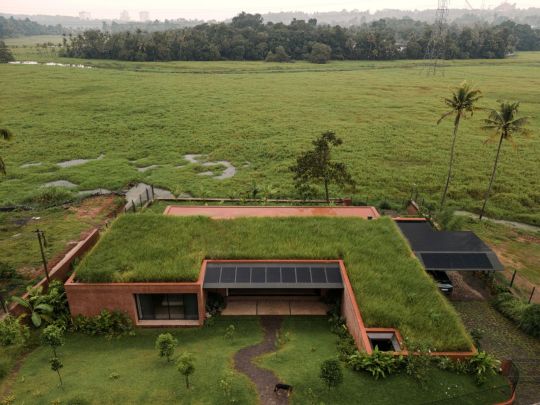

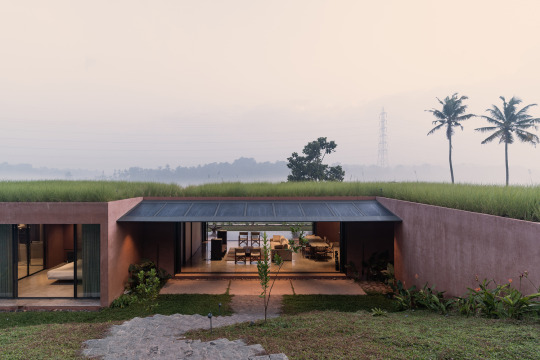

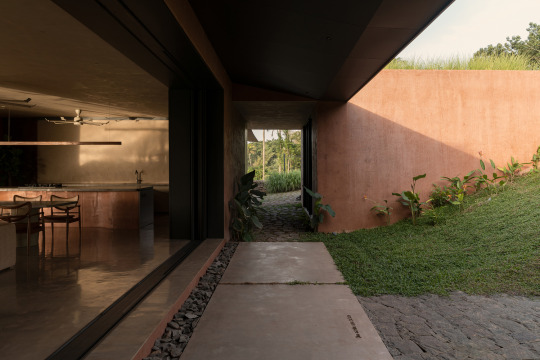
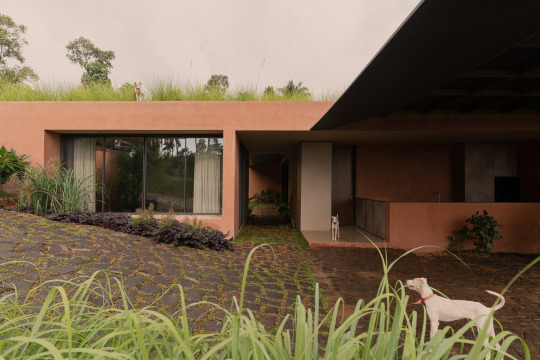







Alarine Earth Home, Koshi, India,
Zarine Jamshedji Architects Conceived in collaboration with builder Cornelis Alan Beuke
Photo Credit: Syam Sreesylam
#art#design#architecture#interior design#interiors#minimalism#earth home#india#koshi#alarine#zarine jamshedji#cornelis alan beuke#solar energy#sustainability#grassland#holistic#green roof
840 notes
·
View notes
Photo

Invisible Solar
Invisible Solar is a new PV technology that take on the appearance of any building material. Each Invisible Solar module is more than a photovoltaic panel, it also is an active architectural element with various functionality.
Disguising solar panels as ancient Roman tiles in Pompeii

"They look exactly like the terracotta tiles used by the Romans, but they produce the electricity that we need to light the frescoes," says Gabriel Zuchtriegel, Director of the Archaeological Park of Pompeii. This solution is part of a more comprehensive strategy to turn costs into savings opportunities and to embrace sustainable development.
Technically called "traditional PV tiles", the invisible solar panels used in Pompeii come from Camisano Vicentino, a little Italian town with slightly more than 10 000 inhabitants, halfway between Padua and Vicenza. They were created and patented by the family business Dyaqua.

How They Work

Operating of Invisible Solar modules is based on the low molecular density. Each module is composed of a non-toxic and recyclable polymeric compound we properly developed to encourage the photon absorption.
Inside the module there are incorporated standard monocrystalline silicon cells. The surface, that is opaque at the sight but translucent to sun rays, allows the light to enter and feed the cells.

Oh my goodness.
Solar voltaic’s designed for historic contexts that offers architectural and aesthetic integration?
AND they are already installed in Pompeii and not marketing vapourware?
AND they are made by a small Italian family business?
Be still my beating solarpunk heart 🥰 ☀️
via @stml in a forum.
#solarpunk#solar punk#solar power#voltaics#solar panels#terracotta#pompeii#renewables#solar energy#Aesthetic#Architecture
3K notes
·
View notes
Text
577 notes
·
View notes
Link
“Experts are calling time on the fossil age as new analysis shows wind and solar power produced a record amount of the world’s electricity last year.The renewables generated 12 per cent of global electricity in 2022, up from 10 per cent the previous year, according to the report from clean energy think tank Ember.And while a small increase in coal burning pushed electricity emissions up to an all-time high, analysts predict this will be the peak of pollution.”
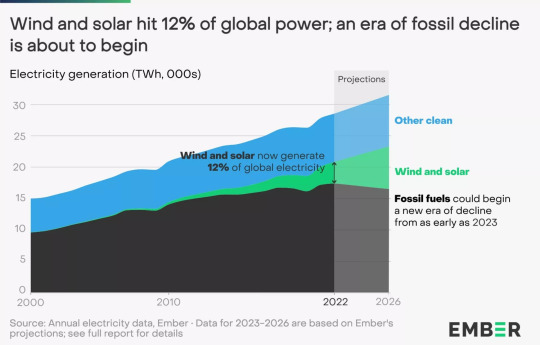
#clean energy#renewable energy#green energy#solar energy#wind energy#hope#good news#energy#environment#climate change#global warming#ecoanxiety#ecogrief#environmental grief#ecological grief#climate anxiety
1K notes
·
View notes
Text
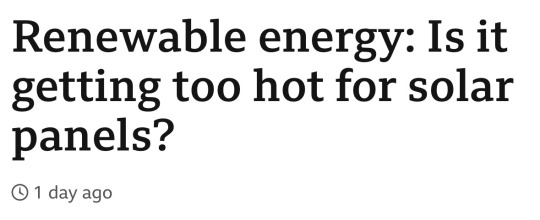

Source

#capitalism#government#solar energy#solar panels#solar power#renewable electricity#climate change#news#current events#the left#ban fossil fuels#green energy#green new deal
913 notes
·
View notes
Text
185 notes
·
View notes
Photo

Percentage of power that come from solar.
120 notes
·
View notes
Text
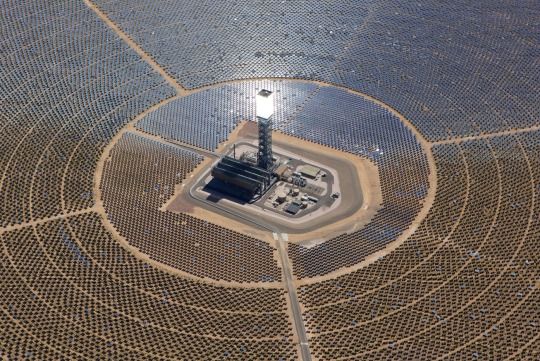
The Noor Power Plant in Ouarzazate, Morocco
source
#Morocco#marrakech#upload#solarpunk#solar field#solar power#solar plant#solar#tech#technology#reflection#light#energy#aerial view#earth from above#landscape#places#solar energy#Ouarzazate#noor power plant#Europe
230 notes
·
View notes
Text
Scientists have developed a new solar-powered system to convert saltwater into fresh drinking water which they say could help reduce dangerous the risk of waterborne diseases like cholera.
Via tests in rural communities, they showed that the process is more than 20% cheaper than traditional methods and can be deployed in rural locations around the globe.
Building on existing processes that convert saline groundwater to freshwater, the researchers from King’s College London, in collaboration with MIT and the Helmholtz Institute for Renewable Energy Systems, created a new system that produced consistent levels of water using solar power, and reported it in a paper published recently in Nature Water.
It works through a process called electrodialysis which separates the salt using a set of specialized membranes that channel salt ions into a stream of brine, leaving the water fresh and drinkable. By flexibly adjusting the voltage and the rate at which salt water flowed through the system, the researchers developed a system that adjusts to variable sunshine while not compromising on the amount of fresh drinking water produced.
Using data first gathered in the village of Chelleru near Hyderabad in India, and then recreating these conditions of the village in New Mexico, the team successfully converted up to 10 cubic meters, or several bathtubs worth of fresh drinking water. This was enough for 3,000 people a day with the process continuing to run regardless of variable solar power caused by cloud coverage and rain.
[Note: Not sure what metric they're using to calculate daily water needs here. Presumably this is drinking water only.]
Dr. Wei He from the Department of Engineering at King’s College London believes the new technology could bring massive benefits to rural communities, not only increasing the supply of drinking water but also bringing health benefits.
“By offering a cheap, eco-friendly alternative that can be operated off the grid, our technology enables communities to tap into alternative water sources (such as deep aquifers or saline water) to address water scarcity and contamination in traditional water supplies,” said He.
“This technology can expand water sources available to communities beyond traditional ones and by providing water from uncontaminated saline sources, may help combat water scarcity or unexpected emergencies when conventional water supplies are disrupted, for example like the recent cholera outbreaks in Zambia.”
In the global rural population, 1.6 billion people face water scarcity, many of whom are reliant on stressed reserves of groundwater lying beneath the Earth’s surface.
However, worldwide 56% of groundwater is saline and unsuitable for consumption. This issue is particularly prevalent in India, where 60% of the land harbors undrinkable saline water. Consequently, there is a pressing need for efficient desalination methods to create fresh drinking water cheaply, and at scale.
Traditional desalination technology has relied either on costly batteries in off-grid systems or a grid system to supply the energy necessary to remove salt from the water. In developing countries’ rural areas, however, grid infrastructure can be unreliable and is largely reliant on fossil fuels...
“By removing the need for a grid system entirely and cutting reliance on battery tech by 92%, our system can provide reliable access to safe drinking water, entirely emission-free, onsite, and at a discount of roughly 22% to the people who need it compared to traditional methods,” He said.
The system also has the potential to be used outside of developing areas, particularly in agriculture where climate change is leading to unstable reserves of fresh water for irrigation.
The team plans to scale up the availability of the technology across India through collaboration with local partners. Beyond this, a team from MIT also plans to create a start-up to commercialize and fund the technology.
“While the US and UK have more stable, diversified grids than most countries, they still rely on fossil fuels. By removing fossil fuels from the equation for energy-hungry sectors like agriculture, we can help accelerate the transition to Net Zero,” He said.
-via Good News Network, April 2, 2024
#water#water scarcity#clean water#saline#desalination#off grid#battery technology#solar power#solar energy#fossil fuels#water shortage#india#hyderabad#new mexico#united states#uk#united kingdom#good news#hope#aquifers
810 notes
·
View notes
Text
The United States solar energy boom is finally taking off - in the worst way. In the Mojave desert and other federal lands across the West, utility-scale installations are putting gigawatt-hours of energy on the board and powering millions of homes. But the designs are sloppy, the labor conditions are horrific, and the environmental damage is incalculable. Ancient joshua trees are being clear cut, endangered desert tortoises are being left for dead, the vast biotic carbon stores of Mojave soils are being upturned, and the reflectivity of enormous expanses of desert are being altered, affecting the planetary climate.
But it doesn't have to be this way. There's a type of energy that requires no fuel and no land. It hardly even needs transmission lines, as it can be built at the site of use: rooftop solar. Every hour of the day, rooftops across the United States soak up enough sun to generate petawatts of power. Estimates for their potential to offset US energy demand range from 13 percent to over 100. Yet at present, only around 2 percent of US energy is generated by rooftop.
And then there's land area that's already been developed. Just by building solar on degraded lands, focusing on superfund sites, reservoirs, and farmland, researchers estimate we could generate more than enough to offset today's national energy demand. While there are points of dispute concerning some projections, the conclusion is clear: between the potential of degraded lands, rooftops, wind, and storage - plus existing hydro, nuclear, and other zero carbon energy sources, there's really no need to tear up the rare and fragile ecosystems of our deserts.
1K notes
·
View notes
Text
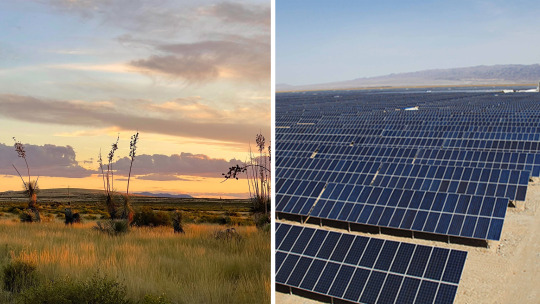
People who think that replacing a wild ecosystem (left pic) with a solar plant (right pic) is "good for the environment" are seriously delusional. Solar panels require a global supply chain, (fossil fuel-based) mining and refining of rare-earth minerals, denuding of areas, and regular washing, all of which are extremely ecologically destructive. They also have a relatively short life and become problematic toxic waste afterwards. Humans have existed sustainably for hundreds of thousands of years prior to the advent of civilization and thrived - believe it or not - without any of these 'green' energy technologies. If we wish to survive and thrive again we must return to those ways.
#earth first!#earth liberation#earth love#green anarchy#anticiv#anarcho primitivism#anti civ#anarchy#anprim#anprimgang#luddism#deep ecology#luddite#ecocentrism#biocentrism#bright green lies#scam#solarpunk#solar#solar energy#solar power#green politics#eco anarchism#ecology#protect environment#wildlife#anti tech#ecocide#clean energy
124 notes
·
View notes
Text
233 notes
·
View notes